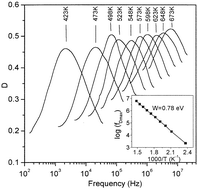Glass nanocomposites in the system (100 −
x)Li2B4O7–xSrBi2Ta2O9
(0 ≤
x
≤ 22.5, in molar ratio) were fabricated via a melt quenching technique followed by controlled heat-treatment. The as-quenched samples were confirmed to be glassy and amorphous by differential thermal analysis (DTA) and X-ray powder diffraction (XRD) techniques, respectively. The phase formation and crystallite size of the heat-treated samples (glass nanocomposites) were monitored by XRD and transmission electron microscopy (TEM). The relative permittivities (εr′) of the glass nanocomposites for different compositions were found to lie in between that of the parent host glass (Li2B4O7) and strontium bismuth tantalate (SBT) ceramic in the
frequency range 100 Hz–40 MHz at 300 K, whereas the dielectric loss (D) of the glass nanocomposite was less than that of both the parent phases. Among the various dielectric models employed to predict the effective relative permittivity of the glass nanocomposite, the one obtained using the Maxwell’s model was in good agreement with the experimentally observed value. Impedance analysis was employed to rationalize the electrical behavior of the glasses and glass nanocomposites. The pyroelectric response of the glasses and glass nanocomposites was monitored as a function of temperature and the pyroelectric coefficient for glass and glass nanocomposite (x
= 20) at 300 K were 27 µC m−2 K−1 and 53 µC m−2 K−1, respectively. The ferroelectric behavior of these glass nanocomposites was established by P vs. E hysteresis loop studies. The remnant polarization (Pr)
of the glass nanocomposite increases with increase in SBT content. The coercive field (Ec) and Pr for the glass nanocomposite (x
= 20) were 727 V cm−1 and 0.527 µC cm−2, respectively. The optical transmission properties of these glass nanocomposites were found to be composition dependent. The refractive index (n
= 1.722), optical polarizability (αm
= 1.266 × 1023 cm3) and third-order nonlinear optical susceptibility (χ(3)
= 3.046 × 10−21 cm3) of the glass nanocomposite (x
= 15) were larger than those of the as-quenched glass. Second harmonic generation (SHG) was observed in transparent glass nanocomposites and the deff for the glass nanocomposite (x
=
20) was found to be 0.373 pm V−1.

You have access to this article
 Please wait while we load your content...
Something went wrong. Try again?
Please wait while we load your content...
Something went wrong. Try again?


 Please wait while we load your content...
Please wait while we load your content...